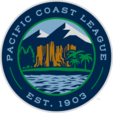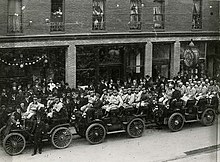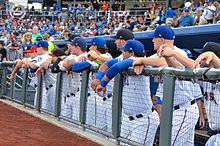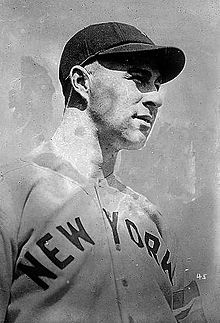Pacific Coast League
 | |
| Classification | Triple-A(1958–present) Open (1952–1957) Triple-A (1946–1951) Double-A(1912–1945) Class-A(1904–1911) Independent (1903) |
|---|---|
| Sport | Baseball |
| Founded | 1903 |
| No. of teams | 10 |
| Country | United States |
| Most recent champion(s) | Oklahoma City Dodgers(2023) |
| Most titles | San Francisco Seals(14) |
| Official website | milb |
ThePacific Coast League(PCL) is aMinor League Baseballleague that operates in theWestern United States.Along with theInternational League,it is one of two leagues playing at theTriple-Alevel, which is one grade belowMajor League Baseball(MLB).
The PCL was one of the premier regional baseball leagues in the first half of the 20th century. Although it was never recognized as a true major league, to which it aspired, its quality of play was considered very high. A number of top stars of the era, includingJoe DiMaggioandTed Williams,were products of the league. In 1958, with the arrival of major league teams on the west coast and the availability of televised major league games, the PCL's modern era began with each team signing Player Development Contracts to becomefarm teamsof major league clubs. Following MLB's reorganization of the minor leagues in 2021, it operated as theTriple-A Westfor one season before switching back to its previous moniker in 2022.
A league champion is determined at the end of each season. TheSan Francisco Sealswon 14Pacific Coast League titles,the most in the league's history, followed by theLos Angeles Angels(12) and theAlbuquerque DukesandPortland Beavers(8).
History
[edit]Formation and early history
[edit]The Pacific Coast League was formed on December 29, 1902, when officials from the California State League (1899–1902) met inSan Franciscofor the purpose of expanding the league beyondCalifornia.Six franchises were granted. These were theLos Angeles Angels,Oakland Oaks,Portland Beavers,Sacramento Senators,San Francisco Seals,andSeattle Indians.A dispute over territories owned by thePacific Northwest League,in which the PCL had placed franchises, and the PCL's allowing blacklisted players to compete led to theNational Association of Professional Baseball Leagues(NAPBL) labeling the PCL as an outlaw league.[1]
The mild climate of the West Coast, especially California, allowed the league to play longer seasons, sometimes starting in late February and ending as late as the beginning of December. During the 1905 season the San Francisco Seals set the all-time PCL record by playing 230 games.[2]Teams regularly played between 170 and 200 games in a season until the late 1950s. This allowed players, who were often career minor leaguers, to hone their skills, earn an extra month or two of pay, and reduce the need to find off-season work. These longer seasons gave owners the opportunity to generate more revenue. Another outcome was that a number of the all-time minor league records for season statistical totals are held by players from the PCL.

The inaugural 1903 season, which consisted of over 200 scheduled games for each team, began on March 26.[3]The Los Angeles Angels finished the season in first place with a 133–78 (.630) record, making them the firstleague champions.
In 1904, NAPBL presidentPatrick T. Powersbrokered terms with the PCL, clearing it of its outlaw status and designating it as a Class A league. In 1909, the league classification was raised to Double-A. In 1919, with the earlier addition of theSalt Lake City BeesandVernon Tigers,league membership reached eight teams for the first time. While the league had experienced little commercial success up to this point, the 1920s were a turning point which saw increased attendance and teams fielding star players.[1]
TheGreat Depressionof the 1930s resulted in a lower quality of play due to the league's salary reduction. Still, a number of top stars, includingJoe DiMaggio,Ted Williams,Bobby Doerr,andOx Eckhardt,competed on PCL teams that decade. Also helping attendance was the introduction of night games. At Sacramento'sMoreing Field,the Sacramento Solons and the Oakland Oaks played the first night baseball game, five years before any major league night game, on June 10, 1930. TheHollywood StarsandSan Diego Padreswere added to the league in the 1930s as well.[1]
A near-major league
[edit]During the first half of the 20th century, the Pacific Coast League developed into one of the premier regional baseball leagues. The cities enfranchised by the other two high-minor leagues, theInternational Leagueand theAmerican Association,were generally coordinated geographically with the major leagues, but such was not the case with the PCL. With no major league baseball team existing west ofSt. Louis,the PCL was unrivaled for American west coast baseball. Although it was never recognized as a true major league, its quality of play was considered very high. Drawing from a strong pool of talent in the area, the PCL produced many outstanding players, including such future major-leagueHall of FamersasJoe DiMaggio,Ted Williams,Tony Lazzeri,Paul Waner,Earl Averill,Bobby Doerr,Joe Gordon,andErnie Lombardi.Amid success experienced afterWorld War II,league PresidentPants Rowlandbegan to envision the PCL as a third major league. During 1945 the league voted to become a major league.[4]However, theAmerican LeagueandNational Leaguewere uninterested in allowing it to join their ranks.[1]
While many PCL players went on to play in the major leagues, teams in the league were often successful enough that they could offer competitive salaries to avoid being outbid for their players' services. Some players made a career out of the minor leagues. One of the better known wasFrank Shellenback,whose major league pitching career was brief,[5]but who compiled a record PCL total of 295 wins against 178 losses. (It should be mentioned, however, that Shellenback's long career in the PCL was largely due to his use of the spitball, banned in the major leagues in 1920, not the competitive salaries offered by PCL clubs.)[citation needed]Many former major league players came to the PCL to finish their careers after their time in the majors had ended.
In 1952, the PCL became the only minor league in history to be given the "Open" classification, a grade above the Triple-A level. This limited the rights of major league clubs to draft players from the PCL, and was considered an act toward the circuit becoming a third major league.[1]
Sudden decline
[edit]The shift to the Open classification came just as minor league teams from coast to coast suffered a sharp drop in attendance, primarily due to the availability of major league games on television. The hammer blow to the PCL's major league dreams came in 1958 with the arrival of the first MLB teams on the west coast (theLos Angeles DodgersandSan Francisco Giants). As a result, three of the PCL's flagship teams (theLos Angeles Angels,Hollywood Stars,andSan Francisco Seals) were immediately forced to relocate to smaller markets. TheOakland Oakshad moved to Canada two years before the Giants arrived. TheSan Diego PadresandSeattle Rainierssuffered the same fate when they were displaced by major league teams, the newPadresand thePilots,respectively, in 1969. Additionally, the PCL lost customers to the major league teams which then occupied the same territory. The league never recovered from these blows. The Pacific Coast League reverted to Triple-A classification in 1958, where it remained, and soon diminished in the public eye to nothing more than another minor league.
Moving beyond the coast
[edit]The PCL began to spread out across the nation, and internationally, in the 1950s. Previously,Salt Lake Cityhad been the easternmost city in the league. In 1956, theOakland Oaksrelocated toCanadawhere they became theVancouver Mounties,the circuit's first international team. Two years later, theLos Angeles Angelsmoved to become theSpokane Indiansand theSan Francisco Sealsbecame thePhoenix Giants.[1]
The league continued to expand throughout the country in the 1960s. Clubs representing new cities during the decade included theDallas Rangers,Denver Bears,Hawaii Islanders,Indianapolis Indians,Oklahoma City 89ers,Tacoma/Phoenix Giants,andTucson Toros.From 1964 to 1968 the PCL swelled to twelve teams. TheAlbuquerque DukesandVancouver Canadianswere a few of several teams to begin play in the 1970s.[1]Several new teams arrived in the 1980s, such as theCalgary Cannons,Colorado Springs Sky Sox,Edmonton Trappers,andLas Vegas Stars,but the league began to stabilize as franchise relocations became less frequent.[1]
Further expansion
[edit]In 1998, the Pacific Coast League took on five teams from the disbandingAmerican Association,which had operated in the Midwest, and a sixth franchise was added to the league as an expansion team, thus providing the scheduling convenience of an even number of teams. The addition of theIowa Cubs,Nashville Sounds,Oklahoma RedHawks,Omaha Royals,New Orleans Zephyrs,and the expansionMemphis Redbirdsgrew the league to an all-time-high 16 clubs.[1]Despite its name, the league now extended well beyond the Pacific coast, stretching fromWestern WashingtontoMiddle Tennessee;half of its teams were located east of theRocky Mountains.
The league's presence in Canada diminished and ended in the early 2000s, as the Vancouver Canadians moved to Sacramento to become theRiverCatsin 2000 (however, a short-season A club replaced that one there), the Calgary Cannons moved toAlbuquerque, New Mexico,to become theAlbuquerque Isotopesin 2003, and theEdmonton Trappers,the circuit's final Canadian team moved toRound Rockin 2005. Of the cities represented in the PCL in its heyday, onlySalt Lake CityandSacramentoremain, and even these were represented by franchises different from those that originally called these cities home. In 2005, the Pacific Coast League became the first minor league ever to achieve a season attendance of over 7 million. In 2007, league attendance reached an all-time high of 7,420,095.[6]
In 2019, the team previously known as theColorado Springs Sky Soxrelocated toSan Antonio, Texasand continued play in the PCL as theSan Antonio Missions,assuming the identity of a team which had previously competed in the Double-ATexas League.[7]This move was accompanied by realignment in the American Conference. Nashville and Memphis moved to the Northern Division, and Oklahoma City and San Antonio moved to the Southern Division.[8]In a further move, theNew Orleans Baby Cakesrelocated toWichita, Kansaswhere they became known as the Double-AWichita Wind Surge.[9]
Takeover by Major League Baseball
[edit]The start of the 2020 season was postponed due to theCOVID-19 pandemicbefore ultimately being cancelled on June 30.[10][11]As part of Major League Baseball's 2021 reorganization of the minor leagues, the Pacific Coast League was reduced to 10 teams and temporarily renamed the "Triple-A West" for the 2021 season.[12]Following MLB's acquisition of the rights to the names of the historical minor leagues, the Triple-A West was renamed the Pacific Coast League effective with the 2022 season.[13]
Structure and season
[edit]The league is divided into two divisions, East and West, of five teams each. As of the 2022 season, all teams play a 150-game schedule, beginning in late March and concluding in late September.[14]
Championship and interleague play
[edit]
Beginning with the 2023 season, the regular season is split into two halves. After the completion of the season, the winners of each half meet in a best-of-three series to determine aleague champion.[15]The PCL champion then meets theInternational League's champion in theTriple-A National Championship Game,a single game to determine an overall champion of Triple-A baseball, which has been held annually since 2006, excluding 2020 and 2021. Previously, the PCL champion also competed in theTriple-A World Series(1983, 1998–2000),Junior World Series(1919), and other sporadic postseason competitions throughout the league's history.
Other interleague play occurred during theTriple-A All-Star Game.Traditionally, the game took place on the day after the mid-summerMajor League Baseball All-Star Game.[16]The game was meant to mark a symbolic halfway-point in the season (though not the mathematical halfway-point which, for most seasons, is usually one month prior). During the All-Star break, no regular-season games were scheduled for two days before the All-Star Game itself.[17]
Current teams
[edit]

200miles
Rules
[edit]The Pacific Coast League plays by the same rules listed in theOfficial Baseball Rulespublished by Major League Baseball. One exception was the use of thedesignated hitter(DH). Whereas the application of the DH rule in Major League Baseball is determined by the identity of the home team, with the rules of the home team's league applying to both teams, PCL pitchers hit when both clubs were National League affiliates and they agreed to have their pitchers hit. Two National League affiliated clubs may agree to use the DH instead. The reason for this is that as players move up and get closer to reaching the majors, teams prefer to have the rules follow (as closely as possible) those of the major leagues. The DH is always used when one or both teams are American League affiliates.[18]Since MLB's adoption of the universal DH in 2022, this no longer is an issue.
Other differences lay in the use of professional baseball'space-of-playinitiatives which began to be implemented in 2015. A 15-secondpitch clockis used when no runners were on base; 20 seconds are allowed with runners present.[19]Teams are limited to five mound visits during a nine-inning game.[20]Pitchers are required to face a minimum of three consecutive batters until the side is retired or the pitcher is injured and unable to continue playing.[20]
Teams timeline
[edit]Note: Teams in italics are PCL "classic" teams from the league's height in the 1950s.
Source:[21]
- Los Angeles Angels(1903–1957) →Spokane Indians(1958–1971) →Albuquerque Dukes(1972–2000) →Portland Beavers(2001–2010) →Tucson Padres(2011–2013) →El Paso Chihuahuas(2014–present)
- Oakland Oaks(1903–1955) →Vancouver Mounties(1956–1962) →Dallas-Fort Worth Rangers(1963) →Dallas Rangers(1964) →Vancouver Mounties(1965–1969) →Salt Lake City Bees(1970) →Salt Lake City Angels(1971–1974) →Salt Lake City Gulls(1975–1984) →Calgary Cannons(1985–2002) →Albuquerque Isotopes(2003–present)
- Portland Beavers(1919–1972) →Spokane Indians(1973–1982) →Las Vegas Stars(1983–2000) →Las Vegas 51s(2001–2018) →Las Vegas Aviators(2019–present)
- Portland Beavers(1978–1993) →Salt Lake Buzz(1994–2000) →Salt Lake Stingers(2001–2005) →Salt Lake Bees(2006–present)
- Sacramento Senators(1903) →Tacoma Tigers(1904)→Tacoma Tigers/Sacramento(1905)[nb 1]→Fresno Raisin Eaters(1906)[nb 2]→Sacramento Sacts(1909–1913) →Sacramento/Mission Wolves(1914) →Salt Lake City Bees(1915–1925) →Hollywood Stars(1926–1935) →San Diego Padres(1936–1968) →Eugene Emeralds(1969–1973) →Sacramento Solons(1974–1976) →San Jose Missions(1977–1978) →Ogden A's(1979–1980) →Edmonton Trappers(1981–2004) →Round Rock Express(2005–present)
- San Francisco Seals(1903–1957) →Phoenix Giants(1958–1959) →Tacoma Giants(1960–1965) →Phoenix Giants(1966–1985) →Phoenix Firebirds(1986–1997) →Tucson Sidewinders(1998–2008)[22]→Reno Aces(2009–present)[23]
- Vancouver Canadians(1978–1999) →Sacramento River Cats(2000–present)
- Vernon Tigers(1909–1912) →Venice Tigers(1913–1914) →Venice/Vernon Tigers(1915) →Vernon Tigers(1916–1925) →Mission Bells(1926–1927) →Mission Reds(1928–1937) →Hollywood Stars(1938–1957) →Salt Lake City Bees(1958–1965) →Tacoma Cubs(1966–1971) →Tacoma Twins(1972–1977) →Tacoma Yankees(1978) →Tacoma Tugs(1979) →Tacoma Tigers(1980–1994) →Tacoma Rainiers(1995–present)
Former American Association teams
[edit]One league team was acquired by the PCL following the disbandment of theAmerican Associationafter the 1997 season.
- Oklahoma City 89ers(1963–1968)[nb 3]→Oklahoma RedHawks(1998–2008) →Oklahoma City RedHawks(2009–2014) →Oklahoma City Dodgers(2015–2023) →Oklahoma City Baseball Club(2024–present)
Former Atlantic League teams
[edit]One league team joined the PCL from the independentAtlantic Leaguein the 2021 reorganization.[24]
- Sugar Land Skeeters(2021) →Sugar Land Space Cowboys(2022–present)
Former teams
[edit]Two former league teams played in the PCL from 1964 to 1968. Each one had played in theInternational Leagueduring the 1963 season, and each was transferred to the American Association after the 1968 season.
- Arkansas Travelers(1964–1965) →Tulsa Oilers(1966–1968)
- Indianapolis Indians(1964–1968)
Seven former league teams were transferred to other leagues in conjunction with the 2021 reorganization of the minors. Memphis, which was created as an expansion team in 1998, was transferred to theInternational Leaguealong with Iowa, Nashville, and Omaha, which joined the PCL from the American Association in 1998. Wichita, which also traces its roots to the American Association, was moved to theTexas Leaguealong with San Antonio. Fresno was transferred to theCalifornia League.
- Nashville Sounds(1998–2020)
- Iowa Cubs(1998–2020)
- Memphis Redbirds(1998–2020)
- Denver Bears(1963–1968)[nb 4]→New Orleans Zephyrs(1998–2016) →New Orleans Baby Cakes(2017–2019) →Wichita Wind Surge(2020)
- Omaha Royals(1998) →Omaha Golden Spikes(1999–2001) →Omaha Royals(2002–2010) →Omaha Storm Chasers(2011–2020)
- Portland Browns(1903–1904) →Portland Giants(1905) →Portland Beavers(1906–1917)[nb 5]→Sacramento Senators(1918–1935) →Sacramento Solons(1936–1960) →Hawaii Islanders(1961–1987) →Colorado Springs Sky Sox(1988–2018) →San Antonio Missions(2019–2020)
- Seattle Siwashes(1903–1906) →Seattle Rainiers(1919–1921)[nb 6]→Seattle Indians(1922–1937) →Seattle Rainiers(1938–1964) →Seattle Angels(1965–1968) →Tucson Toros(1969–1997) →Fresno Grizzlies(1998–2020)
Notes
[edit]- ^The 1905 Tacoma Tigers were moved back to Sacramento in the middle of the 1905 season due to poor play, then were moved again to Fresno the following season.
- ^The 1907–1908 Sacramento Cordovas played in the California League after returning from Fresno.
- ^The Oklahoma City 89ers were members of the American Association in 1962 and from 1969 to 1997.
- ^Denver/New Orleans were members of the American Association from 1969 to 1997.
- ^The 1917 Portland Beavers ceased operations, and its slot in the PCL was offered to Sacramento.
- ^The 1907–1918 Seattle club played in the Northwest League and Pacific Coast International League.
Presidents
[edit]Seventeen presidents led the PCL before its 2021 reorganization:[25][26]
- 1902–1903: James Moran
- 1903–1906: Eugene F. Bert
- 1907–1909:J. Cal Ewing
- 1910–1911: Judge Thomas F. Graham
- 1912–1919: Allan T. Baum
- 1920–1923: William H. McCarthy
- 1924–1931: Harry A. Williams
- 1932–1935: Hyland H. Baggerly
- 1936–1943:W. C. Tuttle
- 1944–1954:Clarence H. Rowland
- 1955: Claire V. Goodwin
- 1956–1959:Leslie O'Connor
- 1960–1968:Dewey Soriano
- 1968–1973: William B. McKechnie Jr.
- 1974–1978: Roy Jackson
- 1979–1997:Bill Cutler
- 1998–2020:Branch B. Rickey
Past champions
[edit]League champions have been determined by different means since the Pacific Coast League's formation in 1903. With few exceptions, most PCL champions through 1927 were simply the regular season pennant winners.[27]However, a few seasons during this time did feature a postseason championship series to crown a champion. It was not until the mid-1930s that the league instituted regular postseason play that was only sporadically cancelled due to financial problems or other factors.[28]Beginning with 2023, the regular-season is split into two halves, and the winners of each half meet in a best-of-three series for the league championship.[29]
TheSan Francisco Sealswon 14 PCL championships, the most among all teams in the league, followed by theLos Angeles Angels(12) and theAlbuquerque DukesandPortland Beavers(8).
Awards
[edit]
The PCL recognizes outstanding players and team personnel annually near the end of each season.
MVP Award
[edit]TheMost Valuable Player Award,first awarded in 1927, is given to honor the best player in the league. The award is voted on by team managers, general managers, broadcasters, and media representatives from around the league, as are all PCL year-end awards.[30]
Pitcher of the Year Award
[edit]ThePitcher of the Year Award,awarded sporadically from 1957 to 1974 and continuously since 2001, serves to recognize the league's best pitcher. Pitchers were also eligible to win the MVP Award from 1927 to 2000.[30]
Top MLB Prospect Award
[edit]TheTop MLB Prospect Award,created in 1952 as the Rookie of the Year Award and issued from 1952 to 1972 and since 1998, is given to the best player with no prior PCL experience.[30]
Manager of the Year Award
[edit]TheManager of the Year Award,started in 1967, is given to the league's top manager.[30]
Executive of the Year Award
[edit]The Executive of the Year Award, first awarded in 1974, honored team executives who have achieved success in the area of attendance figures, promotions, and community involvement.[30]
Hall of Fame
[edit]The Pacific Coast League Hall of Fame was established in 1942 to honor league players, managers, and executives who have made significant contributions to the league's ideals. The Hall of Fame inducted its first class of 12 men in 1943. The Hall became dormant after 1957, but was revived in 2003, the PCL's centennial season. Today, the Hall of Fame Committee seeks to recognize worthy players throughout the league's history who have made contributions to the league. New members are elected before the start of each season.[31]
See also
[edit]- List of Pacific Coast League no-hitters
- List of Pacific Coast League records
- List of Pacific Coast League stadiums
- Sports league attendances
References
[edit]- ^abcdefghi"Pacific Coast League Year-By-Year Standings".2017 Pacific Coast League Sketch & Record Book.Pacific Coast League. 2017. p. 141.
- ^Weiss, William J., ed. (1969). "Records".Pacific Coast League Record Book.Pacific Coast League. p. 30.
- ^Bauer, Carlos (March 30, 2003)."The Formation of the Pacific Coast League".Pacific Coast League. Archived fromthe originalon June 17, 2018.RetrievedFebruary 4,2024.
- ^"Pacific Coast League Votes to Become a Major League".The Milwaukee Journal.Milwaukee, Wisconsin. AP. December 5, 1945. p. L6.RetrievedJuly 29,2013.
- ^"Frank Shellenback Statistics and History".Baseball-Reference.2012.RetrievedMay 15,2012.
- ^"Pacific Coast League: Attendance".milb.Minor League Baseball.RetrievedSeptember 17,2015.
- ^"San Antonio to join PCL beginning in 2019".Pacific Coast League.June 21, 2017.RetrievedJune 21,2017.
- ^"Sounds Announce 2019 Home Schedule".Nashville Sounds.Minor League Baseball. August 1, 2018.RetrievedAugust 1,2018.
- ^"Wichita Rolls out a Logo Finalist for New Baseball Team, but No Name".KAKE.October 2, 2019.RetrievedOctober 7,2019.
- ^"A Message From Pat O'Conner".Minor League Baseball.March 13, 2020.RetrievedMay 5,2020.
- ^"2020 Minor League Baseball Season Shelved".Minor League Baseball.June 30, 2020.RetrievedJuly 1,2020.
- ^Mayo, Jonathan (February 12, 2021)."MLB Announces New Minors Teams, Leagues".Major League Baseball.RetrievedFebruary 12,2021.
- ^"Historical League Names to Return in 2022".Minor League Baseball.March 16, 2022.RetrievedMarch 16,2022.
- ^Franco, Anthony (February 3, 2022)."Triple-A Baseball Season Expanded to 150 Games".MLB Trade Rumors.RetrievedMarch 21,2022.
- ^"2023 Triple-A National Championship Game Set for Sept. 30 in Las Vegas".Minor League Baseball.March 28, 2023.RetrievedMarch 28,2023.
- ^"Omaha Storm Chasers and Werner Park to Host 2015 Triple-A Baseball All-Star Game".Omaha Storm Chasers.Minor League Baseball. March 5, 2014.RetrievedAugust 19,2014.
- ^"Durham Lands 2014 Triple-A ASG".Minor League Baseball. February 20, 2013.RetrievedAugust 19,2014.
- ^"MiLB Frequently Asked Questions".The Official Site of Minor League Baseball.2012.RetrievedApril 10,2017.
- ^"MiLB announces pace-of-play rules for 2018".MILB.March 14, 2018.RetrievedMarch 15,2018.
- ^ab"MiLB announces pace-of-play rules for 2019".MILB.March 29, 2019.RetrievedMarch 29,2019.
- ^"Pacific Coast League (AAA) Encyclopedia and History".Baseball Reference.Sports Reference LLC.RetrievedAugust 8,2017.
- ^Nothaft, Mark (January 3, 2017)."What happened to the Phoenix Firebirds?".Arizona Republic.RetrievedJuly 6,2017.
- ^"PCL approves Sidewinders sale; Reno gets site".The Arizona Daily Star.July 13, 2007.RetrievedFebruary 4,2008.
- ^"Atlantic League (Independent) Encyclopedia and History".Baseball-Reference.Sports Reference.RetrievedMarch 22,2022.
- ^"Former Presidents".Pacific Coast League.Minor League Baseball.RetrievedApril 7,2017.
- ^Bauer, Carlos."The Formation of the Pacific Coast League".Pacific Coast League.Minor League Baseball.RetrievedApril 7,2017.
- ^"Past Champions".Pacific Coast League.Minor League Baseball. Archived fromthe originalon June 12, 2018.RetrievedJune 1,2020.
- ^"Post-Season Play in the Pacific Coast League".Triple-A Baseball.Archived fromthe originalon March 8, 2021.RetrievedJune 1,2022.
- ^"2023 Triple-A National Championship Game Set for Sept. 30 in Las Vegas".Minor League Baseball.March 28, 2023.RetrievedMarch 28,2023.
- ^abcdef"Pacific Coast League Award Winners".Pacific Coast League.Minor League Baseball.RetrievedMay 9,2020.
- ^"Pacific Coast League Hall of Fame".Pacific Coast League.Minor League Baseball.RetrievedMarch 3,2015.
